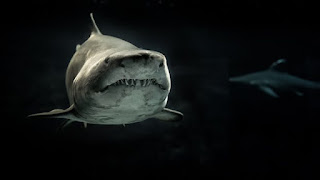The fish fossils at Canowindra are all of freshwater fish.
Generally fish are adapted to either a fresh or a saltwater environment. Salt water is more dense than fresh so buoyancy is different.
Osmotic pressure is different in salt and freshwater. That means that if a freshwater fish were put in salt water its body cells would tend to lose water so it couldn't survive for long.
Tuesday 19 June 2018
Wednesday 16 May 2018
GREAT WHITE SHARK
As Mother's Day has just recently passed, I wondered what sharks contribute to motherhood.
As if the Great White needs any more bad press, they are also OVPVIVIPAROUS. This means that the eggs hatch and the babies develop inside the mother's body. Since the female has no placenta to nourish the babies, they eat any unfertilized eggs and then each other. Naturally very few pups are born at a time since they've already eaten their siblings.
That's right baby sharks are called pups.
Some sharks have a placenta similar to mammals. After fertilization of the eggs inside the mother a yolk sac forms and attaches to the uterine wall. The placenta then transfers nutrients to the developing embryo and the pups are born live and fully developed. Examples include bull sharks, reef sharks and hammerheads.
Wednesday 21 February 2018
GREAT TIMING !
The Grunion Fish from California synchronise their breeding cycle with the spring tides.
At the peak of a spring tide large numbers of Grunion deliberately strand themselves on the shore. The females bury their tails in the sand and lay their eggs. The males are entwined around them and release sperm to fertilise the eggs. The fish then propel themselves backwards to catch a wave to carry them back into the ocean. On the next spring tide (about 15 days later) the eggs hatch and the babies swim off in the high tide.
The Grunion Fish from California synchronise their breeding cycle with the spring tides.
At the peak of a spring tide large numbers of Grunion deliberately strand themselves on the shore. The females bury their tails in the sand and lay their eggs. The males are entwined around them and release sperm to fertilise the eggs. The fish then propel themselves backwards to catch a wave to carry them back into the ocean. On the next spring tide (about 15 days later) the eggs hatch and the babies swim off in the high tide.
Wednesday 14 February 2018
ELECTRIFYING
Some fish are able to sense their surroundings by changes in an electric field generated around them by modified muscle cells. The changes are picked up by sensors along the fish's body. The nature of these changes depends on how well objects conduct electricity..Some fish also use electricity to stun their prey. Some electric eels generate up to 550 volts.
Thursday 18 January 2018
Staying Afloat
The group of fish which evolved with bony skeletons also evolved a way of staying afloat without the constant need to keep swimming.
They developed a swim bladder which is a bag of air that can be filled or emptied by diffusion of gases or by expelling the gases direct
This way a fish can control its buoyancy and level in the water.
They developed a swim bladder which is a bag of air that can be filled or emptied by diffusion of gases or by expelling the gases direct
This way a fish can control its buoyancy and level in the water.
Compare a picture of a shark and a fish.
What other differences might help to make the fish such a manoeuvrable swimmer?
Tuesday 9 January 2018
FISH FACTS - PERPETUAL MOTION
Did you know a charging shark cannot stop. It can swerve but it can't swim in reverse. If it stops beating its tail it sinks.
Rays and skates, which have skeletons made of cartilage the same as sharks, have given up on the energy consuming task of constantly beating their tails. They have become bottom, dwellers. Their tails have become thin and whip like and some have developed poisonous barbs on the end
Subscribe to:
Posts (Atom)







